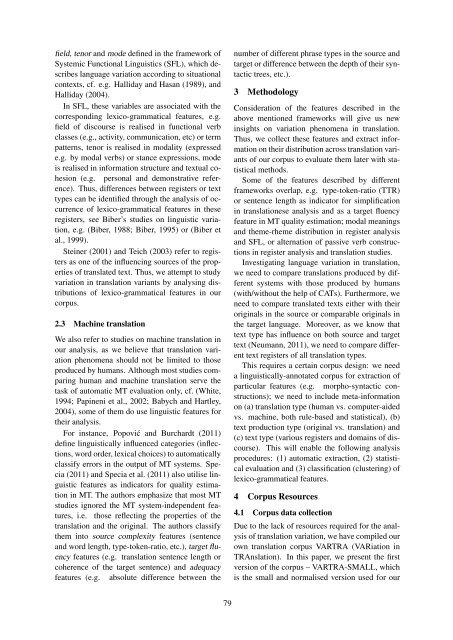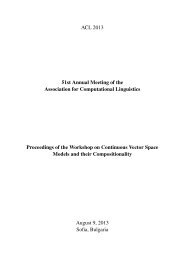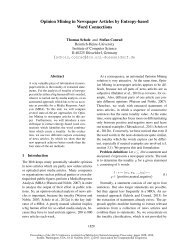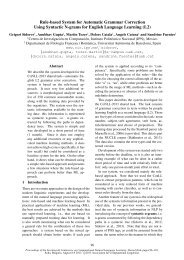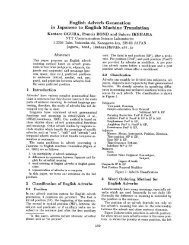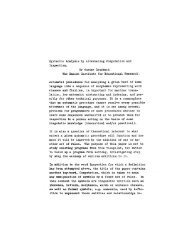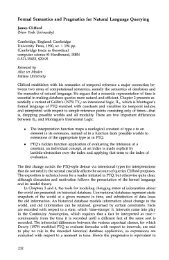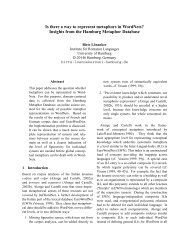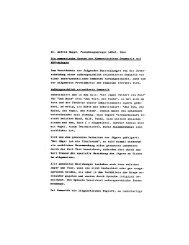VARTRA: A Comparable Corpus for Analysis of Translation Variation
VARTRA: A Comparable Corpus for Analysis of Translation Variation
VARTRA: A Comparable Corpus for Analysis of Translation Variation
Create successful ePaper yourself
Turn your PDF publications into a flip-book with our unique Google optimized e-Paper software.
field, tenor and mode defined in the framework <strong>of</strong><br />
Systemic Functional Linguistics (SFL), which describes<br />
language variation according to situational<br />
contexts, cf. e.g. Halliday and Hasan (1989), and<br />
Halliday (2004).<br />
In SFL, these variables are associated with the<br />
corresponding lexico-grammatical features, e.g.<br />
field <strong>of</strong> discourse is realised in functional verb<br />
classes (e.g., activity, communication, etc) or term<br />
patterns, tenor is realised in modality (expressed<br />
e.g. by modal verbs) or stance expressions, mode<br />
is realised in in<strong>for</strong>mation structure and textual cohesion<br />
(e.g. personal and demonstrative reference).<br />
Thus, differences between registers or text<br />
types can be identified through the analysis <strong>of</strong> occurrence<br />
<strong>of</strong> lexico-grammatical features in these<br />
registers, see Biber’s studies on linguistic variation,<br />
e.g. (Biber, 1988; Biber, 1995) or (Biber et<br />
al., 1999).<br />
Steiner (2001) and Teich (2003) refer to registers<br />
as one <strong>of</strong> the influencing sources <strong>of</strong> the properties<br />
<strong>of</strong> translated text. Thus, we attempt to study<br />
variation in translation variants by analysing distributions<br />
<strong>of</strong> lexico-grammatical features in our<br />
corpus.<br />
2.3 Machine translation<br />
We also refer to studies on machine translation in<br />
our analysis, as we believe that translation variation<br />
phenomena should not be limited to those<br />
produced by humans. Although most studies comparing<br />
human and machine translation serve the<br />
task <strong>of</strong> automatic MT evaluation only, cf. (White,<br />
1994; Papineni et al., 2002; Babych and Hartley,<br />
2004), some <strong>of</strong> them do use linguistic features <strong>for</strong><br />
their analysis.<br />
For instance, Popović and Burchardt (2011)<br />
define linguistically influenced categories (inflections,<br />
word order, lexical choices) to automatically<br />
classify errors in the output <strong>of</strong> MT systems. Specia<br />
(2011) and Specia et al. (2011) also utilise linguistic<br />
features as indicators <strong>for</strong> quality estimation<br />
in MT. The authors emphasize that most MT<br />
studies ignored the MT system-independent features,<br />
i.e. those reflecting the properties <strong>of</strong> the<br />
translation and the original. The authors classify<br />
them into source complexity features (sentence<br />
and word length, type-token-ratio, etc.), target fluency<br />
features (e.g. translation sentence length or<br />
coherence <strong>of</strong> the target sentence) and adequacy<br />
features (e.g. absolute difference between the<br />
number <strong>of</strong> different phrase types in the source and<br />
target or difference between the depth <strong>of</strong> their syntactic<br />
trees, etc.).<br />
3 Methodology<br />
Consideration <strong>of</strong> the features described in the<br />
above mentioned frameworks will give us new<br />
insights on variation phenomena in translation.<br />
Thus, we collect these features and extract in<strong>for</strong>mation<br />
on their distribution across translation variants<br />
<strong>of</strong> our corpus to evaluate them later with statistical<br />
methods.<br />
Some <strong>of</strong> the features described by different<br />
frameworks overlap, e.g. type-token-ratio (TTR)<br />
or sentence length as indicator <strong>for</strong> simplification<br />
in translationese analysis and as a target fluency<br />
feature in MT quality estimation; modal meanings<br />
and theme-rheme distribution in register analysis<br />
and SFL, or alternation <strong>of</strong> passive verb constructions<br />
in register analysis and translation studies.<br />
Investigating language variation in translation,<br />
we need to compare translations produced by different<br />
systems with those produced by humans<br />
(with/without the help <strong>of</strong> CATs). Furthermore, we<br />
need to compare translated texts either with their<br />
originals in the source or comparable originals in<br />
the target language. Moreover, as we know that<br />
text type has influence on both source and target<br />
text (Neumann, 2011), we need to compare different<br />
text registers <strong>of</strong> all translation types.<br />
This requires a certain corpus design: we need<br />
a linguistically-annotated corpus <strong>for</strong> extraction <strong>of</strong><br />
particular features (e.g. morpho-syntactic constructions);<br />
we need to include meta-in<strong>for</strong>mation<br />
on (a) translation type (human vs. computer-aided<br />
vs. machine, both rule-based and statistical), (b)<br />
text production type (original vs. translation) and<br />
(c) text type (various registers and domains <strong>of</strong> discourse).<br />
This will enable the following analysis<br />
procedures: (1) automatic extraction, (2) statistical<br />
evaluation and (3) classification (clustering) <strong>of</strong><br />
lexico-grammatical features.<br />
4 <strong>Corpus</strong> Resources<br />
4.1 <strong>Corpus</strong> data collection<br />
Due to the lack <strong>of</strong> resources required <strong>for</strong> the analysis<br />
<strong>of</strong> translation variation, we have compiled our<br />
own translation corpus <strong>VARTRA</strong> (VARiation in<br />
TRAnslation). In this paper, we present the first<br />
version <strong>of</strong> the corpus – <strong>VARTRA</strong>-SMALL, which<br />
is the small and normalised version used <strong>for</strong> our<br />
79


